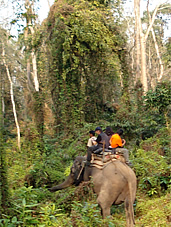 |
Nepal National Parks Chitwan |
|
|
 |
Rhinos
to loose their army protection
August
2002 |
 |
The
Chitwan National Park is one of the highlights Nepal can offer to
its visitors. Every year thousands of local and foreign visitor come to
Chitwan NP to see antelopes, tigers, bears, several species of birds, gharial
crocodiles and last, but not least the famous one-horned rhinos. |
The
visitors pay good money to see all these animals in an amazing landscape
dominated by the Narayani river system. The park is guarded by the National
Park Service and the Royal Nepal Army (RNA). The biggest threat for the
endangered rhinos is poaching. The government have to spend a lot of money
to fight against the Maoist insurgency. The protection of the park is too
expensive for the national army, government officials say. The RNA want
to withdraw its patrols from the park. WWF Nepal is in alert.
Study
on translocation of antelopes
June
2002 |
A
study on the habitation and adaptation for the translocation of some species
of antelopes at the Chitwan National Park from the Royal Shuklaphanta
Wildlife Reserve has been initiated.
The
study was started for timely protection of antelopes on the backdrop of
inbreeding and natural catastrophe. Antelope which has been listed as endangered
species in the world is only found in the protected areas of Nepal and
India. In Nepal, it is found only in the Royal Shuklaphanta Wildlife Reserve
and the Bardiya National Park numbering 2,514 at Shuklaphanta and only
91 in Bardiya.
The
translocation will be successful because of the same kind of soil, grassland
and bio-diversity in Chitwan and evidences have been found that there were
antelopes in Chitwan before 1950.
The
antelopes' extinction can also cause the extinction of tigers. The wildlife
reserve administration has the challenge to manage the habitation in Shuklaphanta
as antelopes live there in herds of 500 to 700.
Chitwan National Park begins artificial hatching of Gharials
April
2002 |
 |
With
an aim to preserve the rare Gharial crocodile, the Royal Chitwan National
Park (RCNP) have begun collecting the eggs from its natural habitat. The
egg will be hatched under the direct inspection of the RCNP experts. The
RCNP decided to take this step, as the number of crocodile of this species
was decreasing due to different reasons. |
The
eggs of crocodile could not prosper in the natural habitat, as the people
used to steal them for medicine use. Sometimes they were swept away by
flood and were also eaten by wild animals.
Nawalparasi:
Couple held for selling rhino horn
March
2002 |
 |
The
Poaching Protest Unit formed by Chitwan National Park has arrested
a couple in a village of Nawalparasi district who were trying to sell a
rhino horn. The culprits were arrested by Royal Chitwan National
Park employees. The horn of the endangered rhino can cost upto thirty millions
rupees. Two dozens of rhinos were killed in Chitwan National Park
this year among which only horns were recovered so far. |
Chitwan:
Rhino population - Census
March
2002 |
A
census conducted in May 2002 put the population of the Asiatic one-horned
rhino in Nepal at 612, up from 446-466 in 1994. Of these, 544 were in Chitwan National Park, one of the world's best rhino habitats included
in UNESCO's World Heritage Site list, while 67 others were in Royal Bardiya
National Park, and one more in Royal Shukla Phanta Wildlife Reserve.
The
total population of one-horned rhino, which was found in abundance from
Pakistan to Myanmar at the turn of the last century, today stands at 2,618
world wide. Their population in India stands at 1,868, while 138 more live
in captivity in zoos.
Chitwan:
Rhinos killed - Poaching is on the rise
March
2002 |
Park
conservation officials moved deep into the bushes of Royal Chitwan
National Park to capture ten adult rhinos and transport them to Royal Bardiya
National Park in western Nepal.
Officials
at the Department of National Parks and Wildlife Conservation (DNPWC),
the government authority responsible for managing the country's protected
areas, are working together with the technicians of the King Mahendra Trust
for Nature Conservation (KMTNC), World Wide Fund for Nature (WWF) to move
the rhinos.
This
will be last batch of rhinos we are moving from Chitwan to Bardiya, Park
authorities said. Bardiya National Park already have a viable population
of the rare animals. This translocation will be the seventh batch of rhinos
from Chitwan to Bardiya. Officials have already moved nearly 80 rhinos
to what is emerging as the country's second largest habitat of the endangered
animals. The rhino population in Bardiya has already crossed 80, and officials
want to move a few more rhinos to Royal Shukla Phanta Wildlife Reserve
in far-western Nepal. Officials have already moved four rhinos there.
Chitwan:
Rhinos killed - Poaching is on the rise
March
2002 |
Serui-Chuli,
a beautiful spot, situated at the Kaule Village Development Committee,
can be developed as a tourist site. Chitwan Tourism Development Committee
has decided to develop this wonderful site with various scenes and sceneries
into a tourist spot.
The
spot lies about 2,042 metres above the sea level. Visitors can reach the
place in 6-hour walk from Shaktikhar in east Chitwan. "We are going to
develop Serai Chuli as the 'Nagarkot' of our district," said Jagannath
Thapaliya, Deputy president of CDDC. The site offer panoramic view of the
rising sun and also. organisations such as King Mahendra Trust for Nature
Conservation and Nepal Chamber of Commerce and Industry have pledged financial
help to develop the site into a tourist spot.
|







